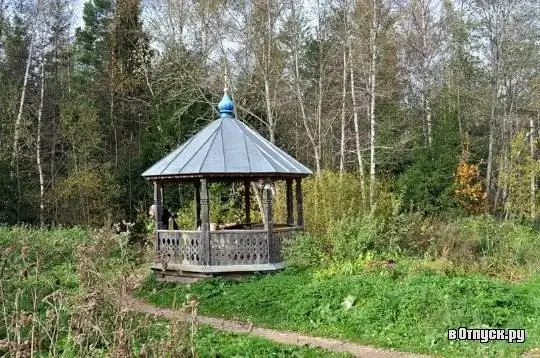
Description of the attraction
There are four holy water springs in Nikandrova Hermitage: in the name of the Monk Nikandr the Hermitage, in the name of the Kazan Icon of the Mother of God, the holy apostles Paul and Peter, or a spring with "dead" and "living" water, as well as a spring in the name of the Monk Alexander Svirsky. Sources of this kind in the Nikandrovaya desert are formed as a result of a break in the earth's crust. Spring water maintains the same temperature at any time of the year, equal to +4 degrees, and also carries an amazing healing and healing power.
According to a legend, the water of one of the sources helped to get rid of eye diseases, as well as relieve diseases associated with joints, and even cure purulent ulcers. The greatest respect and veneration was received by the source, next to which there was a chapel consecrated in the name of Savvaty and Zosima, in which a wooden shrine was kept, which until the end of the 18th century kept the relics of the Monk Saint Nikandr. It has a well-deserved fame and a key located near the chapel called the Picturesque Spring.
The holy source of the Kazan Icon of the Mother of God is located right at the entrance to the monastery itself on the right side; The second name of this sacred spring is "Glaznoy", because it was in this place that many pilgrims healed eye diseases, although drinking water from this source is not recommended due to the fact that the water has a cloudy color associated with the presence of peat, as well as a bitter taste. There is a pointer next to the source showing the location of other sources.
In order to find the spring, consecrated in honor of the Monk Alexander of Svir, you need to walk 1, 3 km from the monastery deep into the forest. According to legend, it was at the place of this spring that Alexander Svirsky himself appeared to the holy Monk Nikandr during his prayers.
Alexander Svirsky was tonsured at the Valaam monastery. He founded a monastery 36 versts from Olonets, located not far from the Svir River. Throughout his life, Alexander supported Nikandr in the hermit lifestyle and always helped him when he saw various kinds of visions. In 1533, Alexander Svirsky died.
The spring named after him has a beautiful bluish water that contains a lot of radon. Popularly, the source is called Yellow, which is associated with the color of the grass, which turns rusty through the waters flowing from the source. Spring water has a yellow color due to the high content of ferrous compounds, which has found application in the treatment of diseases of the gastrointestinal tract. The depth of the source reaches 7 m.
Along the forest path, starting from the monastery, you can come to a hydrogen sulphide spring, consecrated in the name of the holy Reverend Nikandr - this is the most important source of the entire desert. There is a chapel right above the spring. Popularly, the source is called Silver or Dental. In the chapel above the spring, even before the revolution, there was a lid of the saint's coffin, made of oak. There is a belief that in case of a toothache, you need to touch the lid, drink water from the holy spring, and then the pain will pass.
According to the analysis results, spring water contains a large amount of silver ions, which has a noticeable smell of hydrogen sulfide, which is used in the treatment of arthritis, rheumatism, muscles, bones, diseases of the spine, and hydrogen sulfide water is used for baths, rinsing and irrigation.
Two springs in the name of Saints Paul and Peter are located in one chapel: on the right there is a spring with "living" water, and on the left - with "dead" water. With the help of "dead" water, diseases can be cured, but "living" water is especially tasty and very useful for the body. It seems that, since the sources are located nearby, the water should be the same, but the difference lies in the fact that the water rises from different depths and from different layers of rocks, passing through different cracks. This source healed from male and female diseases, diseases of the heart and its vessels, the nervous system.
At the moment, a huge number of pilgrims come to all sources. They bathe in the radon spring in summer and winter, and from the other three they drink water and wash themselves.
Reviews
| All reviews 5 vit 2016-01-12 23:48:40
Nikandrova Desert Sources are just class, in the summer there is a guest refectory with a large assortment of dishes, products are mainly monastic, very tasty.
5 Julia Vitoslavski 2015-28-05 11:51:45 PM
accommodation for pilgrims One day is not enough to visit these places. It is better to stay here for a couple of days, attend the evening and morning services, enjoy the goodness of the springs and the pacification of these places. Breathe in that air and walk through the forests through which Saint Nikander walked. Wonderful welcoming place for o …






